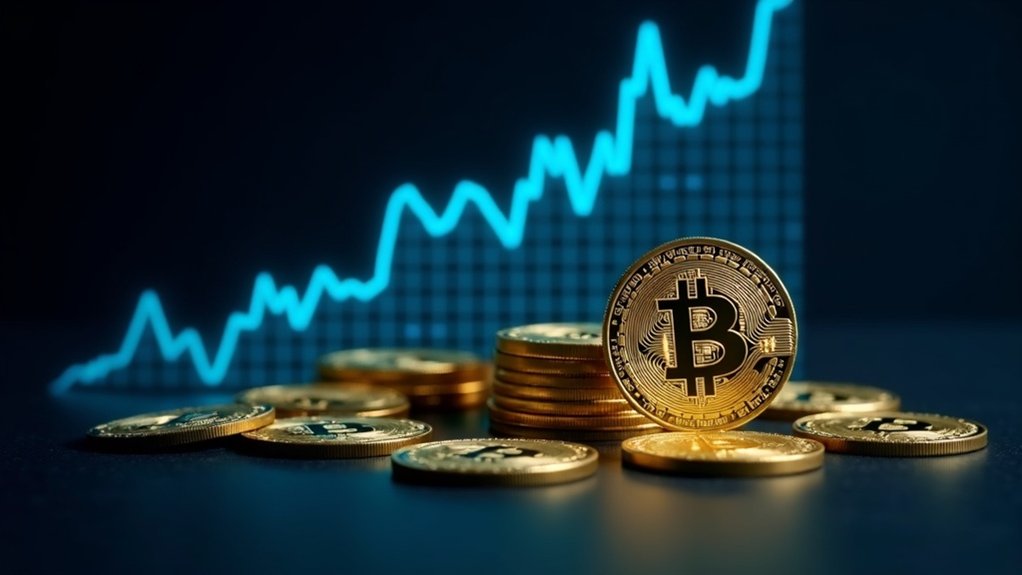Market cap in cryptocurrency represents an asset’s total value, calculated by multiplying current price by circulating supply. It’s not actual money invested—just what the market thinks the crypto is worth right now. Bitcoin’s calculation uses roughly 19.7 million coins in circulation. Displayed prominently on platforms like CoinGecko, it helps classify cryptos into risk categories: large-caps (more stable), mid-caps, and volatile small-caps. Smart investors know it’s just one piece of the evaluation puzzle.
The market cap. It’s the metric everyone in crypto obsesses over, yet many don’t fully understand. Simply put, market cap represents the total value of a cryptocurrency, calculated by multiplying a coin’s current price by its circulating supply. That’s it. Nothing complicated about the math.
Traders check market caps constantly. They’re displayed prominently on platforms like CoinGecko and Coinbase, offering a quick snapshot of a crypto’s size. But here’s the thing—market cap isn’t actually the amount of money invested in a cryptocurrency. It’s just what the market thinks it’s worth right now. Big difference.
Several factors affect market cap daily. Circulating supply changes through token releases, mining rewards, staking, and burns. For Bitcoin specifically, calculations use approximately 19.7 million coins as its circulating supply. The fully diluted market cap considers the maximum possible supply to estimate total potential value.
Meanwhile, token prices swing wildly based on market sentiment and trading volume. When supply increases through mining or token releases, market cap typically grows. When developers burn tokens, supply shrinks, potentially boosting price and market cap.
Investors use market cap to classify cryptocurrencies into risk categories. Large-caps like Bitcoin and Ethereum? Generally more stable. Mid-caps? Balance of growth and stability. Small-caps? Volatile as hell, but possibly moon-bound. The smaller the market cap, the wilder the price swings. That’s just how it works.
Market cap matters because price alone tells you nothing. A $100 token isn’t necessarily more valuable than a $1 token. One might have 10 million coins circulating while the other has 1 billion. Do the math. The second one’s market cap is ten times larger.
Smart investors never look at market cap in isolation. They consider trading volume, liquidity, development activity, and tokenomics too. Coinmarketcap provides volume-weighted average prices from various exchanges to calculate accurate market caps. Market cap is just one piece of the puzzle. A big one, sure, but still just a piece.
When evaluating cryptocurrencies, market cap provides a starting point. It indicates relative size and importance in the ecosystem. Nothing more, nothing less. Use it wisely.
Frequently Asked Questions
How Do Price Manipulations Affect Cryptocurrency Market Cap?
Price manipulations distort cryptocurrency market caps greatly. Tactics like wash trading and pump-and-dump schemes artificially inflate or deflate prices, directly skewing market cap calculations.
Small-cap coins are especially vulnerable—even modest trades can drastically alter their perceived value.
Manipulated market caps mislead investors about true project size and stability. Data aggregators blindly report these distorted figures, compromising cryptocurrency rankings.
The result? Damaged market efficiency and investor trust. Sadly, many decisions are based on these fake numbers. Market’s wild, folks.
Can Stablecoins Have a High Market Cap?
Yes, stablecoins absolutely can have high market caps.
Just look at Tether (USDT) sitting at a massive $83 billion.
USD Coin and DAI aren’t exactly small fry either, both exceeding the billion-dollar mark.
Unlike typical cryptos, their value stays fixed—it’s their circulating supply that changes.
Their popularity comes from practical uses: trading pairs on exchanges, safe havens during volatility, and cross-border payments.
Huge demand, stable price, big market cap. Simple math.
Why Do New Cryptocurrencies Often Have Low Market Caps?
New cryptocurrencies typically have low market caps for several obvious reasons.
Limited circulating supply at launch means fewer tokens multiplied by price.
Initial token prices start low due to limited trading history and investor skepticism.
Most people haven’t heard of them yet – no adoption, no demand.
And let’s face it, they’re risky investments.
Higher volatility scares off cautious investors.
The combination of low price, limited supply, and minimal adoption keeps these new crypto market caps tiny.
Pretty straightforward, really.
How Quickly Can a Cryptocurrency’s Market Cap Change?
A cryptocurrency’s market cap can change in seconds. Price fluctuations instantly affect market cap—it’s simple math.
Small-cap coins see wild swings due to lower liquidity; one whale can tank or pump the whole thing.
Even Bitcoin’s trillion-dollar cap isn’t immune to rapid shifts.
Major news, regulatory announcements, or Elon Musk tweets? Boom—instant market cap earthquake.
Token burns or supply changes create abrupt shifts too.
Crypto never sleeps, and neither does market cap volatility.
Is Market Cap Considered During Regulatory Decisions About Cryptocurrencies?
Market cap absolutely influences regulatory decisions about cryptocurrencies.
Regulators use it as a key metric for evaluating an asset’s significance and potential impact on markets.
Higher market caps typically trigger more scrutiny.
Different sized cryptocurrencies often face varying regulatory treatments – big ones get the spotlight while smaller tokens fly under the radar.
Not the only factor, though.
Regulators also examine trading volume, technological features, and security risks when crafting policies.
Size matters, but it’s not everything.









